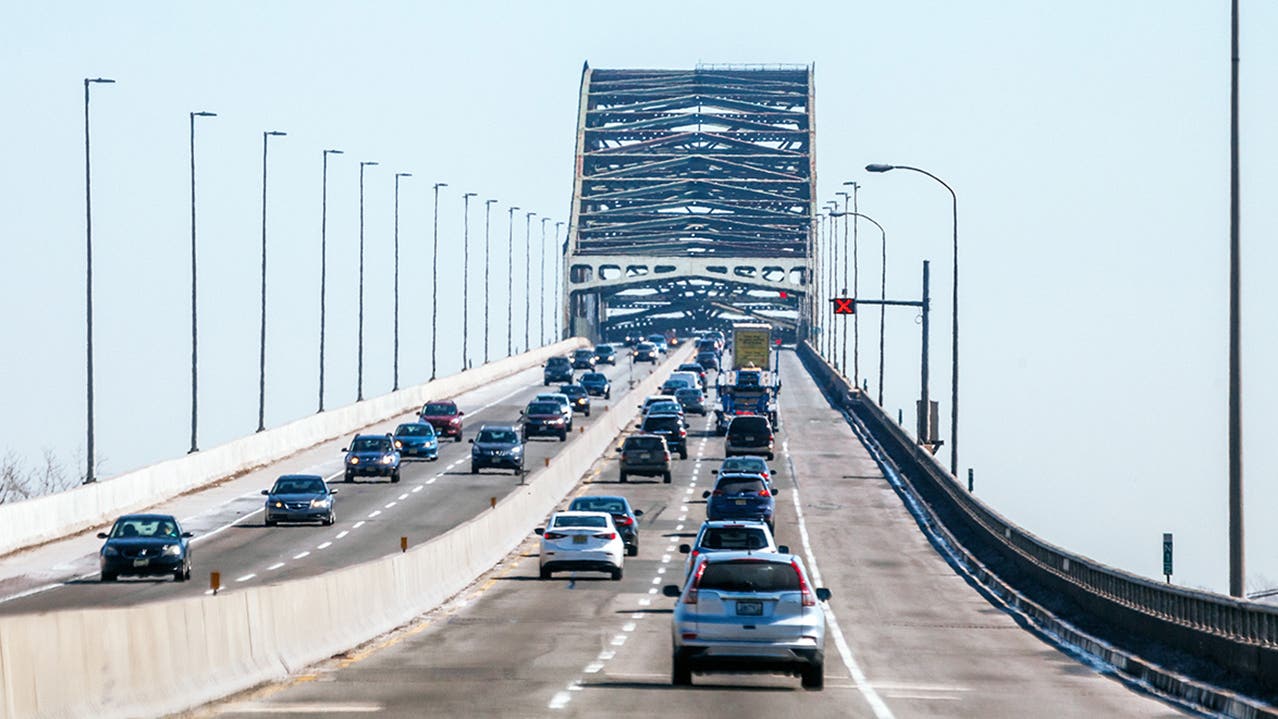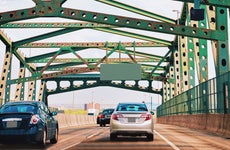New Jersey’s evolving car insurance laws: What you need to know

The Bankrate promise
At Bankrate, we strive to help you make smarter financial decisions. To help readers understand how insurance affects their finances, we have licensed insurance professionals on staff who have spent a combined 47 years in the auto, home and life insurance industries. While we adhere to strict , this post may contain references to products from our partners. Here's an explanation of . Our content is backed by Coverage.com, LLC, a licensed entity (NPN: 19966249). For more information, please see our .
Key takeaways
- The first phase of New Jersey’s latest car insurance requirements took effect back in January 2023 and the second phase will occur in January 2026.
- The cost for liability car insurance coverage for New Jersey drivers increased by an average of $145 per year due to the required higher coverage limits.
- Approximately 1.1 million to 1.2 million vehicles were affected by this change, which accounts for 22 to 30 percent of New Jersey policyholders.
New Jersey has historically had one of the lowest minimum car insurance requirements in the country. To encourage drivers to have more financial protection, the New Jersey legislature enacted a two-step plan that phases in higher minimum liability limits over three years. The first phase began back in January 2023, with the second phase set to take effect in a little over a year. With car insurance premiums at an all-time high, there is ongoing debate about the necessity of this NJ auto insurance increase. Bankrate explains upcoming changes to the coverage requirements New Jersey drivers can expect and how to offset rising insurance rates.
New Jersey car insurance requirements
In August 2022, Governor Bill Murphy signed into law a bill that increases the minimum car insurance limits that drivers must carry in New Jersey. The first phase of these changes went into effect on January 1, 2023, and the second phase will take effect on January 1, 2026.
It is important to note that New Jersey has two minimum car insurance coverage options, a basic and a standard policy. A representative from the New Jersey Department of Banking and Insurance (DOBI) told Bankrate that “[t]he changes in the law apply to standard policies; the law does not apply to basic policies. There are 53,000 basic auto insurance policies in New Jersey.” Drivers who choose the basic car insurance option will not see any changes to their coverage. The changes will only apply to drivers carrying the standard minimum car insurance coverage.
Here’s what the updated New Jersey car insurance requirements look like:
| Coverage type | Prior standard minimum limits | 2023 standard minimum limits | 2026 standard minimum limits |
|---|---|---|---|
| Bodily injury liability (per person) | $15,000 | $25,000 | $35,000 |
| Bodily injury liability (per accident) | $30,000 | $50,000 | $70,000 |
| Property damage liability (per accident) | $5,000 | $25,000 | $25,000 |
| Personal injury projection | $15,000 | $15,000 | $15,000 |
| Uninsured motorist bodily injury (per person) | $15,000 | $25,000 | $35,000 |
| Uninsured motorist bodily injury (per accident) | $30,000 | $50,000 | $70,000 |
| Underinsured motorist bodily injury (per person) | $15,000 | $25,000 | $35,000 |
| Underinsured motorist bodily injury (per accident) | $30,000 | $50,000 | $70,000 |
Why the minimum coverage limits are changing
With car insurance rates already increasing, why is New Jersey changing its minimum car insurance limits and further driving up costs? New Jersey’s minimum liability insurance was previously among the lowest in the country, although the state did require more coverage types than many other states. Mark Friedlander, Director of Corporate Communications at the Insurance Information Institute (Triple-I), noted that:
New Jersey liability limits have not been raised since 1972…an increase to the state’s liability minimum requirements is well past due.
He explained that the prior limits might not cover average claim costs and that the increase was “broadly supported by the insurance industry.” As vehicle and medical costs rise, current minimum limits provide less coverage, increasing financial risk for policyholders.
However, not all experts support the changes. While the 2023 adjustments better align New Jersey’s minimum coverage with other states, opinions differ on the 2026 changes. The Triple-I supports the initial increase but opposes the second phase. “According to estimates from New Jersey auto insurers,” Friedlander said, “approximately 75 percent of all bodily injury liability claims and more than 90 percent of all property damage liability claims could be settled at or below the new Jan. 1, 2023 limits.” He warned that the second increase “will only result in increased premiums for drivers, likely leading some to forego insurance coverage.”
Effects on New Jersey drivers
Industry experts estimate that the minimum limit changes impacted between 22 and 30 percent of New Jersey drivers. According to a representative from the NJ DOBI, “1.1 million to 1.2 million vehicles had coverage below the new 2023 requirement and will see their limits and premiums increase with the new law. The second phase will likely affect more drivers since it increases limits even further.”
When questioned about the impact on premiums, Christine O’Brian, President of the Insurance Council of NJ said “over 1 million drivers are now paying on average $145 more per year for their liability coverage due to the change in the law. This pool of drivers is comprised of those who purchased the prior minimum limits of 15/30/5 and now are required to buy 25/50/25 limits, and typically represent low-income drivers. Unfortunately, these same drivers plus those who always purchased 25/50, totaling over 1.4 million drivers, will see another premium increase in January 2026 when the minimum liability limit rises again to 35/70/25. At this time, it’s unclear what impact this will have on premium, since 35/70 has never been sold in NJ before.”
Car insurance costs are highly personalized, depending on factors like driving history, driver age, vehicle type and coverage options. You might have noticed some premium increases to your minimum coverage insurance back in January 2023 when the first phase was rolled out, but keep in mind that you could see a similar NJ car insurance increase come January 2026, when the second phase is mandated.
In general, the law disproportionately impacts low-income drivers since they typically purchase the minimum liability limits. We know that the average settlement for crashes that involve injuries is $18,000, which is $3,000 more than the old limit, but substantially lower than the new 25/30 limit. NJ essentially is mandating budget-conscious drivers to purchase more coverage than they may need or can afford.— Christine O'Brien, President of the Insurance Council of New Jersey
Drivers may still need more coverage
Even with the higher required limits, drivers may find that minimum limits still do not provide sufficient financial protection. Inflation rose rapidly in 2022 and still has not normalized, which means claims are costing more. The proposed property damage limit is $25,000 while the price data suggest the average cost of a new car in 2024 is around $48,451. Unfortunately, this could mean that inflation is leaving drivers underinsured. If you’re unsure if your coverage is enough to protect your finances, talk to an insurance agent about your current situation.
How to offset NJ car insurance increases
If you find yourself being affected by a NJ auto insurance increase, whether due to the law changes or inflation, there are steps you can take to potentially find the cheapest car insurance for you:
- Compare quotes: Shopping around and comparing quotes from several companies is one of the best ways to find a competitive price. Every company has a different rating method, which means premiums will vary even for the same coverage.
- Utilize discounts: Most car insurance companies offer at least a few discounts that could help you lower your bill. Common savings opportunities include bundling your auto and home insurance, opting for paperless statements or taking part in a telematics program.
- Drive safely: Accidents and tickets increase car insurance rates substantially, so maintaining a clean driving record can help keep your premium down over time. You may even earn an additional safe-driver discount.
Insurance industry experts weigh in
“The resulting back-to-back premium increases could lead to a much higher uninsured motorist rate in the Garden State, which will have a negative impact on every driver. We disagree that a second phase increase (Jan. 1, 2026) was necessary.”
— Mark FriedlanderDirector of Corporate Communications at the Insurance Information Institute
“With inflation reaching a 40-year high and the cost of everything skyrocketing, the American Property Casualty Insurance Association (APCIA) has been concerned with the potential cost increases associated with this new law, particularly for those who are on a fixed income and may now be forced to choose between paying for basic necessities such as gas, rent, groceries, etc. or insurance. Some consumers may have no choice but to opt to forego insurance altogether, a result which would be in no one’s best interest and could raise the uninsured rate in New Jersey — currently the lowest in the nation at 3.1 percent.”
— Alison CooperVice President of State Government Relations for the American Property Casualty Insurance Association
The bottom line
New Jersey’s minimum car insurance coverage limits prior to the first increase in 2023 were among the lowest in the country and may not have been sufficient to cover average claims costs. Increasing the minimum limits could help solve this issue but will also likely increase premiums for a state with an already higher-than-average cost of insurance. This may cause some drivers to opt out of coverage altogether. Additionally, even the new minimum limits may not provide enough financial protection for all drivers. Will New Jersey’s new minimum coverage limit solve one problem only to create another?
Related Articles



